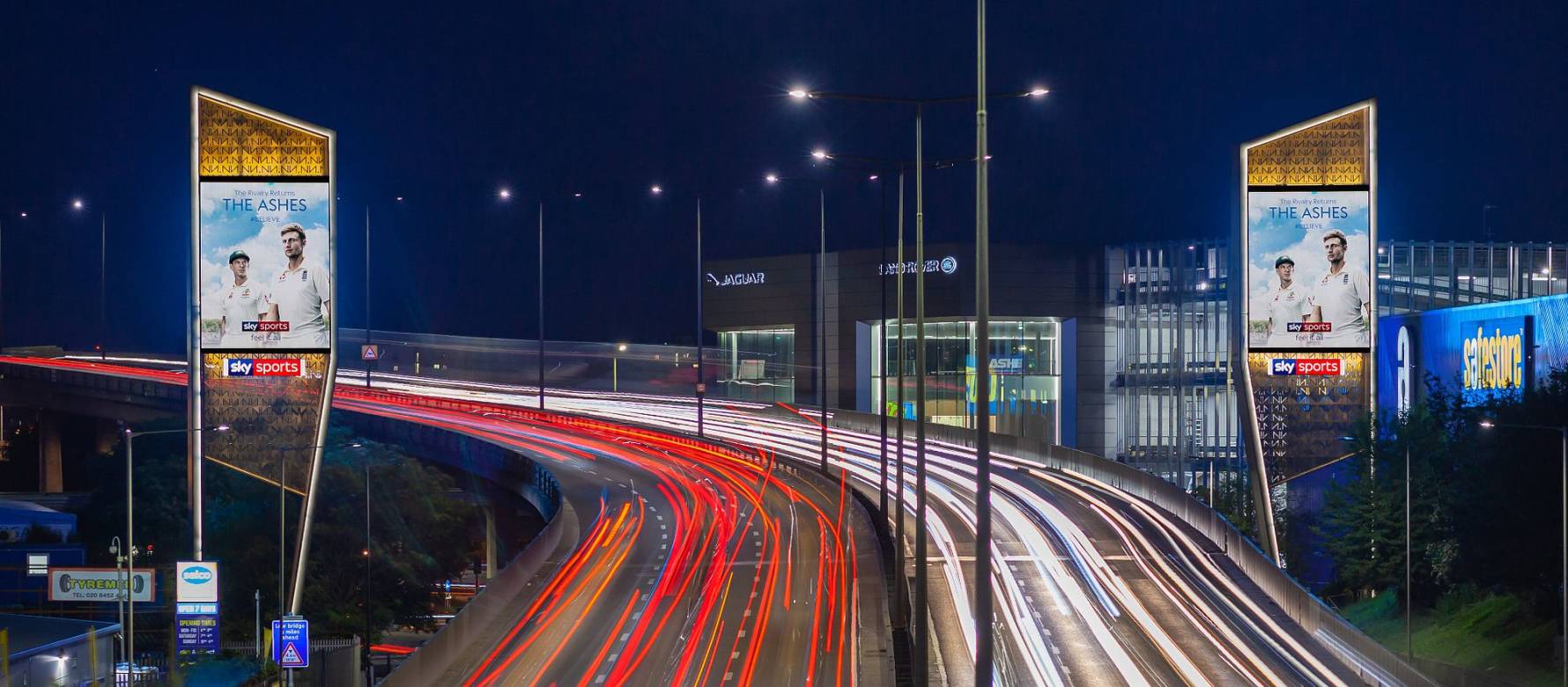
From the Premier League to the Olympics, nothing grips the UK like sports. And with 77%* of viewers saying they notice brands surrounding sporting events, this presents a big opportunity to connect with audiences on a deeper level.
We conducted a survey of 2,000 respondents to reveal some fascinating insights into how audiences perceive brands that advertise during sporting events, and the influence this has on consumer buying behaviour.
After viewing sports-related Out of Home (OOH) marketing content, brand liking increases by 33%. There’s also a 47% increase in immediate brand usage among those who recall seeing the ads.
By tapping into the strong emotions stirred up by sports, brands align themselves with positive values, appear more relevant and activate audiences effectively. Read on to find out what else our survey uncovered.
How do generations differ when it comes to advertising perception/effectiveness during sporting events?
Different age groups interact with and respond to advertisements during sporting events in completely different ways. Our survey revealed that younger age groups show a higher propensity towards both noticing and being influenced by these ads.
Firstly, we found that Gen Z (18-24-year-olds) are more likely to notice ads during sporting events than older generations, with nearly half (49%) of Gen Z respondents stating so.
Gen Z are also the age group that says they’re most likely to purchase a product after repeated exposure to an ad during a sporting event, with 42% claiming they do so. They’re followed by 27% of 25-34-year-olds and 24% of 35-44-year-olds.
The story is roughly similar when it comes to how ads at sporting events affect different generations’ feelings about brand reputation.
A significant proportion (32%) of 18-24-year-olds say their perception of a brand improves after seeing it advertised during a major sporting event, as do 28% of 25-34-year-olds. Similarly, one in four (24%) 18-24-year-olds are inspired to learn more about products advertised during sporting events.

This highlights that the youngest generation in our survey has a propensity to become interested in brands and products that they see advertised at sporting events, indicating that it’s an effective medium for raising brand awareness.
They notice the ads at a high rate, set out to learn more about the brands that are advertising, hold the brands in higher regard and say they’re more likely to purchase a product after repeated exposure to advertising during sporting events.
But how does that translate to actually making purchases?
Previous research has shown that OOH advertising delivers a 47%** uplift in sales, proving that it’s effective at driving purchases as well as influencing brand perception.
In terms of sports advertising specifically, our research shows some interesting figures - such as 18-24-year-olds being more likely to purchase an FMCG product on the same day after seeing it advertised during a sporting event (15%) than they are if they were exposed to the same product through regular advertising (12%).
Key drivers for purchasing a product people saw advertised at a sports event

When we look at the reasons why people purchase products they’ve seen advertised at sporting events, the importance of maintaining brand awareness becomes clear.
25% of people selected brand trust as a key driver for purchasing a product seen advertised at a sports event. And 20% of people say they were moved into action because of brand recognition.
Without a consistent brand presence, brand recognition can flounder. This can negatively impact brand trust, as audiences do not experience the sense of familiarity that helps breed confidence in a brand.
But it’s not all about brand trust and recognition. For 15% of people, a positive association with the event was the primary reason they purchased a product seen advertised. 13% of people chose emotional appeal as the most influential factor, while another 13% cited brand prestige as the key driver for making a purchase.

Across the board, younger generations are more likely to be positively influenced towards buying from a brand they’ve seen advertised at a sports event.
The positive aura surrounding sports events can rub off on brands and influence purchase decisions, particularly among Gen Z and Millennials. One in four (25%) of 18-24-year-olds bought products advertised during sporting events because of a favourable association with the brand. For 25-34-year-olds, the figure stands slightly higher at 27%.
Nearly half (46%) of 18-24-year-olds stated that brand trust was the key driver in purchasing a product. This shows that sporting events can lend their credibility to brands, with brand trust being the top purchase driver among all age groups.
Interestingly, emotional appeal and brand prestige varied between age groups, and did not correlate with an increase in age. 18-24-year-olds and 35-44-year-olds are more likely to purchase products because of a brand’s prestige than its emotional appeal (32 vs 22% and 22% vs 18% respectively).
But for 25-34-year-olds and 45-54-year-olds, emotional appeal holds more significance.
25% of 25-34-year-olds said they purchased a product after seeing it advertised around sports events because of its emotional appeal, while 22% said it was because of the brand’s prestige. For 45-54-year-olds, emotional appeal drove 14% of purchases and brand prestige drove 11%.
Men and women also display different motivations when purchasing products following advertising exposure during a sports event. One in five men (18%) would buy a product because of a positive association with the event, whereas only one in 10 (11%) of women would do the same.
Primary reasons for purchasing a product
We also asked our survey respondents what their primary reasons were for purchasing products in general. These insights provide clues into how to approach messaging and, although not directly related, illustrate why sports advertising can be an effective driver of sales.
For the vast majority of people, product quality (65%) and price (62%) are the primary reasons for purchasing a product. This indicates that brands should focus on conveying value and incorporating price-themed messaging into their ads to activate customers looking to buy.
At the other end of the scale, only 3% of people say that fear of missing out (FOMO) is the reason they buy products. Overall, it’s the product that matters most to consumers, followed by the brand’s values and identity, while factors like scarcity and advertising quality are less relevant when it comes to driving sales.

Why advertise during sporting events?
OOH advertising and sporting occasions are a match made in heaven. When there’s a sporting event on, the nation becomes transfixed - and OOH allows you to bring your brand into the public arena where the action is happening.
You can place your brand in front of a mass audience and lean on the reputation of iconic events. When you associate your brand with these events, you intrinsically link its identity to its values and transform how it is perceived.
Advertising during sports events is a form of occasion-based marketing, which is all about capitalising on heightened consumer interest. By leveraging this interest, you naturally engage audiences and, as our data shows, immediately increase brand usage.
Our final piece of survey data indicates which brands stand to benefit most from advertising during sports events. Product purchase intention is strongly skewed towards food and drink, with 65% of respondents planning to purchase alcohol, 58% planning to buy snacks, 55% intending to purchase soft drinks, 50% looking forward to BBQ food and drinks, and 50% intending to buy chocolate and confectionery around sporting events.

2024 has been a big year for sports fans in the UK. From the Euros to the Olympics, barely a week has passed without a new sporting tournament for viewers to get excited about. And with a new Premier League season underway, the buzz generated by live sports isn’t disappearing anytime soon.
Sports-related OOH advertising boosts brand perception by 68%*, so now is the ideal time to lace up your boots and start thinking about how to tackle your OOH strategy this autumn. Using an array of OOH advertising formats and advanced programmatic OOH buying technology, you can respond to the latest fixtures in real time and target audiences with relevant ads.
The football season provides endless opportunities for advertisers to leverage fan interest - get in touch to discover how we can help you capitalise on the excitement of the season.
Sources:
Bauer Media Outdoor Sporting Intentions Study, March 2024, N=1, 256
* Bauer Media Outdoor Sports Advertising Survey July - September 2023
** Standing on the Shoulder of Giants
SHARE POST
PRESS ENQUIRIES



